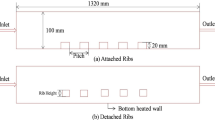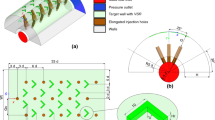Abstract
This research work is directly concerned with the heat transfer involved in a single jet flow covering a heated surface having detached ribs present above the surface. A computational study has been conducted to check the effect due to the presence of such detached ribs. The generalized \(k - \omega\) (GEKO) turbulence model with Reynolds-averaged Navier–Stokes equations formulation has been adopted after validation with the relevant experimental data from the literature. A rectangular rib design was selected for which rib width, height, clearance, pitch and first rib radial distance were varied to study their effect on heat transfer. Local heat transfer distributions were investigated over the target surface, especially focusing on the ribs-based region for different nozzle positions. The thermal performance with and without ribs is compared. A maximum increase in heat transfer of 64% was observed for a normalized nozzle to plate spacing \(z/d\) = 0.5.


















Similar content being viewed by others
Abbreviations
- \(A\) :
-
Hydraulic area of flow in mm2
- \(c\) :
-
Clearance between the ribs and the impingement wall in millimeters
- \(c_{{\text{P}}}\) :
-
Specific heat capacity in J kg−1 K−1
- \(d\) :
-
Nozzle diameter (hydraulic diameter) in millimeters
- \(e\) :
-
Height of rib in millimeters
- \(h\) :
-
Convective heat transfer coefficient in W m−2 K−1
- \(I\) :
-
Turbulence intensity (%)
- \(k\) :
-
Turbulent kinetic energy in J kg−1
- \(l\) :
-
Nozzle length in millimeters
- \(L\) :
-
Length of the impingement plate in millimeters
- \(\dot{m}\) :
-
Mass flow rate of fluid in kg s−1
- \({\text{Nu}}\) :
-
Local Nusselt number
- \({\text{Nu}}_{{{\text{avg}}}}\) :
-
Average Nusselt number
- \({\text{Nu}}_{{{\text{avg}}){\text{o}}}}\) :
-
Average Nusselt number for smooth flow
- \(P\) :
-
Production of energy
- \(p\) :
-
Pitch distance between ribs in millimeters
- \(q\) :
-
Heat flux in W m−2
- \(Q\) :
-
Flow rate in m3 s−1
- \(r\) :
-
Radial distance from stagnation point in millimeters
- \(r_{1}\) :
-
First rib radial distance from the nozzle axis in millimeters
- \({\text{Re}}\) :
-
Reynolds number
- \(S\) :
-
Strain rate tensor
- \(T_{{\text{j}}}\) :
-
Air jet temperature in Kelvins
- \(T_{{\text{r}}}\) :
-
Temperature of the target plate at given radial location in Kelvins
- \(u\) :
-
Axial velocity component in m s−1
- \(u^{\prime }\) :
-
Fluctuating velocity component in axial direction in m s−1
- \(v\) :
-
Fluid velocity component in radial direction in m s−1
- \(\nu^{\prime }\) :
-
Fluctuating velocity component in radial direction in m s−1
- \(w\) :
-
Width of rib in millimeters
- \(x\) :
-
Distance from the stagnation point in the axial direction in millimeters
- \(y\) :
-
Perpendicular distance from the stagnation point along the length of the impingement plate in millimeters
- \(z\) :
-
Nozzle–plate spacing in millimeters
- \(\omega\) :
-
Specific turbulent energy dissipation rate in s−1
- \(\lambda\) :
-
Thermal conductivity in W m−1 K−1
- \(\mu\) :
-
Dynamic viscosity in kg m−1 s−1
- \(\nu\) :
-
Kinematic viscosity of fluid in m2 s−1
- \(\rho\) :
-
Fluid density as defined by ideal gas law in kg m−3
- \(\tau\) :
-
Shear stress in N m−2
- \(\Omega\) :
-
Vorticity in s−1
- ′ :
-
Fluctuation of quantity
- \({\text{avg}}\) :
-
Average
- \({\text{i}}\) :
-
Component in x-direction
- \({\text{j}}\) :
-
Jet
- \({\text{k}}\) :
-
Kinetic energy
- \({\text{NW}}\) :
-
Near wall
- \({\text{o}}\) :
-
For smooth flow
- \({\text{p}}\) :
-
Constant pressure
- \({\text{sep}}\) :
-
Separation
- CFD:
-
Computational fluid dynamics
- GEKO:
-
Generalized k–omega
- LES:
-
Large eddy simulation
- PIV:
-
Particle image velocimetry
- RANS:
-
Reynolds-averaged Navier–Stokes
- SST:
-
Shear stress transport
References
Zuckerman N, Lior N. Jet impingement heat transfer : physics, correlations, and numerical modeling. Adv Heat Transf. 2006;39(06):565–631. https://doi.org/10.1016/S0065-2717(06)39006-5.
Singh D, Premachandran B, Kohli S. Effect of nozzle shape on jet impingement heat transfer from a circular cylinder. Int J Therm Sci. 2015;96:45–69. https://doi.org/10.1016/j.ijthermalsci.2015.04.011.
Koseoglu MF, Baskaya S. The role of jet inlet geometry in impinging jet heat transfer, modeling and experiments. Int J Therm Sci. 2010;49(8):1417–26. https://doi.org/10.1016/j.ijthermalsci.2010.02.009.
Siddique MU, Syed A, Khan SA, Meyer JP. On numerical investigation of heat transfer augmentation of flat target surface under impingement of steady air jet for varying heat flux boundary condition. J Therm Anal Calorim. 2022;147(6):4325–37. https://doi.org/10.1007/s10973-021-10785-4.
Zhang D, Qu H, Lan J, Chen J, Xie Y. International journal of heat and mass transfer flow and heat transfer characteristics of single jet impinging on protrusioned surface. Heat Mass Transf. 2013;58(1–2):18–28. https://doi.org/10.1016/j.ijheatmasstransfer.2012.11.019.
Kim WS, Lee SY. Behavior of a water drop impinging on heated porous surfaces. Exp Therm Fluid Sci. 2014;55:62–70. https://doi.org/10.1016/j.expthermflusci.2014.02.023.
Beitelmal AH, Saad MA, Patel CD. Effects of surface roughness on the average heat transfer of an impinging air jet. Int Commun Heat Mass Transf. 2000;27(1):1–12. https://doi.org/10.1016/S0735-1933(00)00079-8.
Sharif MAR, Ramirez NM. Surface roughness effects on the heat transfer due to turbulent round jet impingement on convex hemispherical surfaces. Appl Therm Eng. 2013;51(1–2):1026–37. https://doi.org/10.1016/j.applthermaleng.2012.10.015.
Xing Y, Weigand B. Experimental investigation of impingement heat transfer on a flat and dimpled plate with different crossflow schemes. Int J Heat Mass Transf. 2010;53(19–20):3874–86. https://doi.org/10.1016/j.ijheatmasstransfer.2010.05.006.
Gabour LA. Wall roughness effects on stagnation-point heat transfer beneath an impinging liquid jet. J Heat Transf. 2016. https://doi.org/10.1115/1.2910887.
Celik N. Effects of the surface roughness on heat transfer of perpendicularly impinging co-axial jet. Heat Mass Transf. 2011. https://doi.org/10.1007/s00231-011-0785-9.
Caliskan S. Flow and heat transfer characteristics of transverse perforated ribs under impingement jets. Int J Heat Mass Transf. 2013;66:244–60. https://doi.org/10.1016/j.ijheatmasstransfer.2013.07.027.
Kanokjaruvijit K, Martinez-Botas RF. Jet impingement on a dimpled surface with different crossflow schemes. Int J Heat Mass Transf. 2005;48(1):161–70. https://doi.org/10.1016/j.ijheatmasstransfer.2004.08.005.
Choi EY, Choi YD, Lee WS, Chung JT, Kwak JS. Heat transfer augmentation using a rib-dimple compound cooling technique. Appl Therm Eng. 2013;51(1–2):435–41. https://doi.org/10.1016/j.applthermaleng.2012.09.041.
El-Gabry LA, Kaminski DA. Experimental investigation of local heat transfer distribution on smooth and roughened surfaces under an array of angled impinging jets. J Turbomach. 2005;127(3):532–44. https://doi.org/10.1115/1.1861918.
Hwang J. Heat Transfer-Friction Characteristic Comparison in Rectangular Channel Arrays of Attached, Detached, and Alternate Attached-Detached Ribs on Two Opposite Walls. Proceedings of the ASME 1997 International Gas Turbine and Aeroengine Congress and Exhibition. 1997;3. V003T09A084. https://doi.org/10.1115/97-GT-488
Tanda G. Effect of rib spacing on heat transfer and friction in a rectangular channel with 45° angled rib turbulators on one/two walls. Int J Heat Mass Transf. 2011;54(5–6):1081–90. https://doi.org/10.1016/j.ijheatmasstransfer.2010.11.015.
Tan L, Zhang JZ, Xu HS. Jet impingement on a rib-roughened wall inside semi-confined channel. Int J Therm Sci. 2014;86:210–8. https://doi.org/10.1016/j.ijthermalsci.2014.06.037.
Wongcharee K, Changcharoen W, Eiamsa-Ard S. Numerical investigation of flow friction and heat transfer in a channel with various shaped ribs mounted on two opposite ribbed walls. Int J Chem React Eng. 2011. https://doi.org/10.1515/1542-6580.2560.
Wang F, Zhang J, Wang S. Investigation on flow and heat transfer characteristics in rectangular channel with drop-shaped pin fins. Propuls Power Res. 2012;1(1):64–70. https://doi.org/10.1016/j.jppr.2012.10.003.
Chung HS, Lee GH, Nine MJ, Bae K, Jeong HM. Study on the thermal and flow characteristics on the periodically arranged semi-circular ribs in a rectangular channel. Exp Heat Transf. 2014;27(1):56–71. https://doi.org/10.1080/08916152.2012.719067.
Kumar A, Saravanasathiyaprabhahar R. Numerical investigation of heat transfer characteristics in a square duct with internal. Int J Innov Res Sci. 2014;3(1):1179–85.
Nine J, Lee GH, Chung HS, Ji M, Jeong H. Turbulence and pressure drop behaviors around semicircular ribs in a rectangular channel. Therm Sci. 2014;18(2):419–30. https://doi.org/10.2298/TSCI111022142N.
AL-Taie AK, Kadham MJ. Numerical heat transfer enhancement in square duct with internal rib. East. Acad. J. 2015;3(1):87–100
Chung H, Park JS, Park S, Choi SM, Rhee DH, Cho HH. Augmented heat transfer with intersecting rib in rectangular channels having different aspect ratios. Int J Heat Mass Transf. 2015;88:357–67. https://doi.org/10.1016/j.ijheatmasstransfer.2015.04.033.
Gugulothu R, Reddy KVK, Somanchi NS, Adithya EL. A review on enhancement of heat transfer techniques. Mater Today Proc. 2017;4(2):1051–6. https://doi.org/10.1016/j.matpr.2017.01.119.
Maradiya C, Vadher J, Agarwal R. The heat transfer enhancement techniques and their thermal performance factor. Beni Suef Univ J Basic Appl Sci. 2018;7(1):1–21. https://doi.org/10.1016/j.bjbas.2017.10.001.
Alenezi AH, Almutairi A, Alhajeri HM, Addali A, Gamil AAA. Flow structure and heat transfer of jet impingement on a rib-roughened flat plate. Energies. 2018. https://doi.org/10.3390/en11061550.
Zu YQ, Yan YY, Maltson J. Numerical study on stagnation point heat transfer by jet impingement in a confined narrow gap. J Heat Transfer. 2009;131(9):1–4. https://doi.org/10.1115/1.3139183.
Brakmann R, Chen L, Poser R, Rodriguez J, Crawford M, Weigand B. Heat transfer investigation of an array of jets impinging on a target plate with detached ribs. Int J Heat Fluid Flow. 2019;78:108420. https://doi.org/10.1016/j.ijheatfluidflow.2019.05.009.
Katti V, Prabhu SV. Heat transfer enhancement on a flat surface with axisymmetric detached ribs by normal impingement of circular air jet. Int J Heat Fluid Flow. 2008;29(5):1279–94. https://doi.org/10.1016/j.ijheatfluidflow.2008.05.003.
Hadipour A, Rajabi M, Maziar Z. Effect of micro-pin characteristics on flow and heat transfer by a circular jet impinging to the flat surface. J Therm Anal Calorim. 2020. https://doi.org/10.1007/s10973-019-09232-2.
Hadipour A, Zargarabadi MR, Mohammadpour J. Effects of a triangular guide rib on flow and heat transfer in a turbulent jet impingement on an asymmetric concave surface Effects of a triangular guide rib on flow and heat transfer in a turbulent jet impingement on an asymmetric concave surface. Phys Fluids. 2020. https://doi.org/10.1063/5.0010480.
A Hellsten (1998) k-omega SST Turbulence Model 29th AIAA fluid dynamics conference. In: AIAA Fluid Dynamic Conference, pp. 2–12, 1998.
Menter FR, Lechner R, Matyushenko A. Best practice : generalized k–w two-equation turbulence model in ANSYS CFD (GEKO). 2019. pp. 1–38
Narayanan V, Seyed-Yagoobi J, Page RH. An experimental study of fluid mechanics and heat transfer in an impinging slot jet flow. Int J Heat Mass Transf. 2004;47(8–9):1827–45. https://doi.org/10.1016/j.ijheatmasstransfer.2003.10.029.
Acknowledgements
The authors want to express their gratitude to the IMME, Khwaja Fareed University of Engineering and Information, to Rahim Yar Khan, for providing the software package, and to NED University of Engineering and Technology, Karachi, for providing the opportunity to work in this particular field of research.
Author information
Authors and Affiliations
Corresponding author
Additional information
Publisher's Note
Springer Nature remains neutral with regard to jurisdictional claims in published maps and institutional affiliations.
Rights and permissions
Springer Nature or its licensor holds exclusive rights to this article under a publishing agreement with the author(s) or other rightsholder(s); author self-archiving of the accepted manuscript version of this article is solely governed by the terms of such publishing agreement and applicable law.
About this article
Cite this article
Rasheed, A., Allauddin, U., Ali, H.M. et al. Heat transfer and fluid flow characteristics investigation using detached ribs in an axisymmetric impinging jet flow. J Therm Anal Calorim 147, 14517–14537 (2022). https://doi.org/10.1007/s10973-022-11640-w
Received:
Accepted:
Published:
Issue Date:
DOI: https://doi.org/10.1007/s10973-022-11640-w




